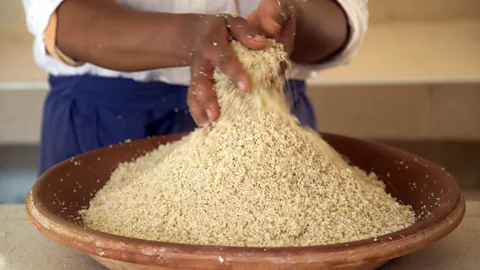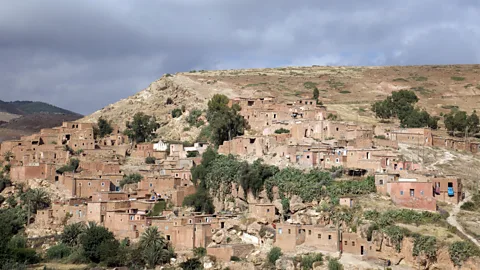Yennayer: North Africa's 3,000-year-old new year's celebration
 Jeff Koehler
Jeff KoehlerThis year will mark the first time that Morocco recognises the Amazigh new year as an official holiday, enjoyed with festive foods like couscous.
On the evening of 12 January, dozens of bonfires burned on the rocky hillside above the village of Tisselday in Morocco's High Atlas Mountains. They were lit by families for Yennayer, the Amazigh (or Berber) new year celebrations. The fires symbolise a cleansing or purification of the past year, explained Ahmed Agouni, a trained geologist and owner of the long-running Irocha guesthouse in his home village of Tisselday, some 1,530m above sea level on the High Atlas eastern slopes.
The Amazigh calendar starts at 950 BCE, when King Sheshonq ascended the throne of Egypt, meaning this year is 2974. For Amazigh communities in Morocco, this Yennayer will be particularly special.
In May 2023, Morocco's King Mohammed VI made the occasion an official national holiday. (It was made one in Algeria at the end of 2017.) After a long history of being marginalised, this is widely seen by the Amazigh community as a welcome step in the growing respect for their culture, as well as the deep connections to the land and the seasonal cycles that they continue to retain.
As North Africa's original inhabitants, the Amazigh (which means "free people" or "noble people"; and is Imazighen in plural) have occupied the region since the beginning of recorded history, and today Morocco and Algeria have the largest Amazigh populations. On the Amazigh calendar, Yennayer marks the ending of the agrarian year and the beginning of the next, said Agouni. "The name comes from yan which means 'first' and ayur which means 'month'," he said.
The date corresponds to the Julian calendar, which is 13 days behind the more globally common Gregorian one. The first day of the new year on 13 January also marks the start of the coldest weeks of the year.
"We don't stay by the fire long, though," said Agouni. "We hurry back home to finish the preparations for dinner."
 Imago/Alamy
Imago/AlamyThat meal, made with foods that symbolise abundance and fertility, is at the heart of Yennayer celebrations. Honouring the harvest and renewal, it's an ode to nature and her bounty. Tradition says that you have to leave the table full in order to ward off the spectre of famine and ensure abundance in the year ahead. As Yennayer is celebrated across North Africa and among the Amazigh diaspora, a diverse set of traditions is observed. But that festive evening meal is a strong constant on a unifying occasion that celebrates Amazigh identity, even if what's on the table changes.
For Agouni and those in his High Atlas village, the main dish to share with family is ourkemen, made with a wide selection of dried legumes (lentils, split peas, chickpeas, white beans, broad beans) and whole grains (corn, wheat, barley) along with sheep's or cow's foot, onions and some light spicing. The name comes from irkm, according to Agouni, which refers to putting something into water, as the legumes are first soaked overnight. Slowly cooked over low-heat to a thick, porridge-like consistency, ourkemen is rich, filling and highly anticipated each year. "It's popular because it represents the widest variety of crops," said Agouni.
Many homes in the High Atlas also prepare tagoula, made from boiled barley or corn grits and eaten with melted smen (ghee), olive oil or argan oil and honey. Hidden in the bottom of the tagoula is a date pit referred to as amnaz ("lucky"). Whoever finds it is considered blessed.
For families in the Ouirgane Valley, an hour south of Marrakech in the High Atlas's western foothills, the date pit often gets secreted into a mound of fine couscous garnished with peeled hardboiled eggs and dusted with cinnamon, said Youssef Bassine, a manager at the boutique hotel Olinto in the valley. But after some rather inauspicious stories of broken teeth, the Bassine family (like numerous others) switched to hiding an almond instead. While not teeth-shatteringly hard, its symbolic luck remains.
 Jeff Koehler
Jeff KoehlerIn Algeria, the dish most widely associated with the holiday is couscous, explained Yasmina Sellam, a trained agronomist, judge on Algeria's Master Chef and author of the award-winning book Mémoire Culinaire de l'Algérie (Culinary Memory of Algeria). "The Yennayer meal is celebrated using storable goods that are part of the food reserve and security." These year-round items generally consist of cereals, legumes and salt-preserved meat. Couscous makes the best Yenneyer meal, she said, because its base is barley or wheat and the broth that tops it includes a broad variety of legumes – beans, chickpeas, black-eyed peas, split peas, lentils – and chicken or kaddid (salted and dried meat). "In popular culture across Algeria, it's imperative that the Yenneyer meal contains these ingredients for the good omen of a prosperous year ahead for the harvests," Sellam explained.
While couscous – known as sksou in Tamazight (the Amazigh language) – at Yennayer might be comparable to a turkey on a Christmas table, there are a couple of other traditional Algerian dishes that adorn festive tables.
For Hanane Abdelli-Tancrede, author of the recently released cookbook Goûts d'Algérie (Tastes of Algeria) and chef and founder of Mama Nissa, a stylish and popular restaurant serving "fast-good" Algerian specialties in Paris's second arrondissement, the dish is rechta, made with fresh noodles, chicken, chickpeas and turnips, and drizzled with a chicken-based "white" (as opposed to red, which is tomato-based) broth flavoured with cinnamon. "Rechta is a festive dish and good to eat for all occasions, including Yennayer," she explained. "It's requested by many customers for this."
Just as at home, the rechta durum wheat pasta served at Mama Nissa – named for her mother, Anissa, who remains "en commande" (in charge) of the kitchen – is homemade, cut very finely in a pasta machine and steamed three times in a couscoussier (a pot-bellied steamer pot with basket). "You should always moisten the pasta before steaming it to help soften and keep it from sticking together," Abdelli-Tancrede advised. "When working the pasta, you must be delicate and not break the strands. The word rechta comes from the Persian rista, which means thread. These 'threads' should be as long as possible."
 Hanane Abdelli-Tancrede
Hanane Abdelli-TancredeAlong with sumptuous, comforting flavour, the dish carries plenty of symbolism. "Yennayer is at the end of the harvest time, so we consume the winter stock. But it is also the beginning of something. For that we add poultry. The hen represents fertility. We want the next season to be auspicious and fruitful," Abdelli-Tancrede said. "It marks an end and also a beginning."
Sweets, of course, play a role in the festivities, especially around Algeria. Baskets of candies, dates, dried figs and nuts are enjoyed by families over tea after the large meal. One name for this basket, explained Abdelli-Tancrede, is trèze, "thirteen" in French. "That's because it should include a mix of 13 different types of candies, dried fruits and nuts."
Children should be warned, though. "We throw the candies gently on the heads of children so that it brings good luck and that the year ahead will be sweet," said Abdelli-Tancrede.
BBC.com's World's Table "smashes the kitchen ceiling" by changing the way the world thinks about food, through the past, present and future.
---
more than three million BBC Travel fans by liking us on Facebook, or follow us on Twitter and Instagram.
